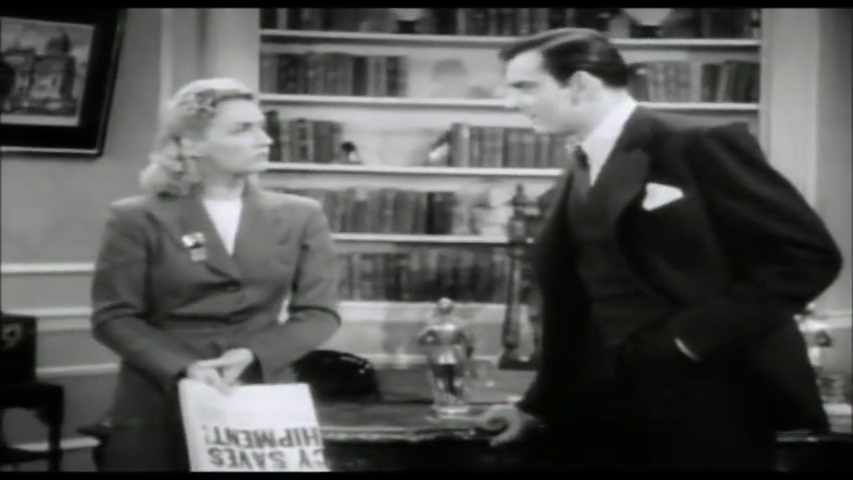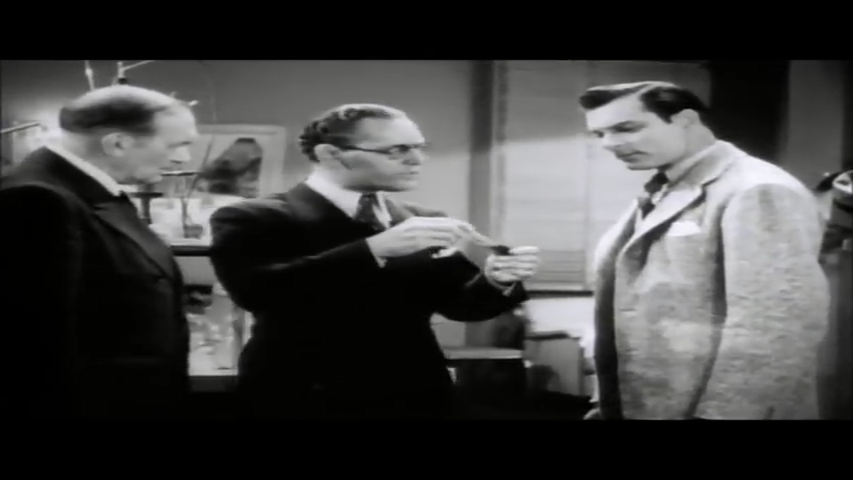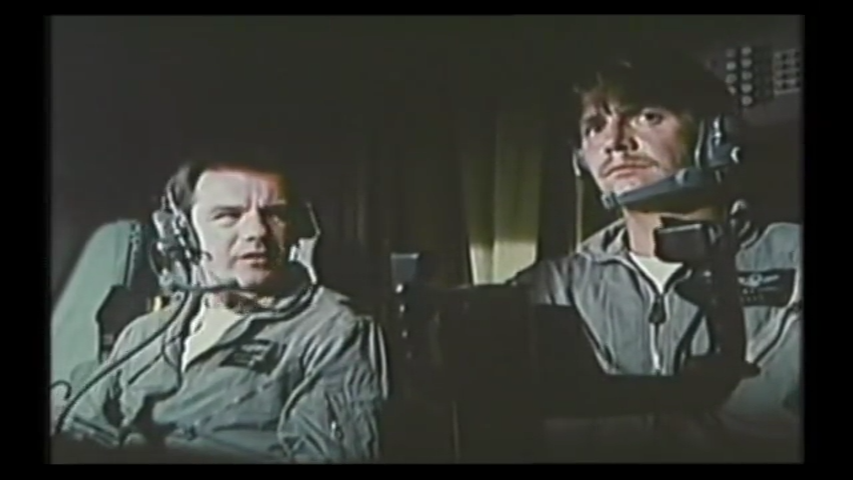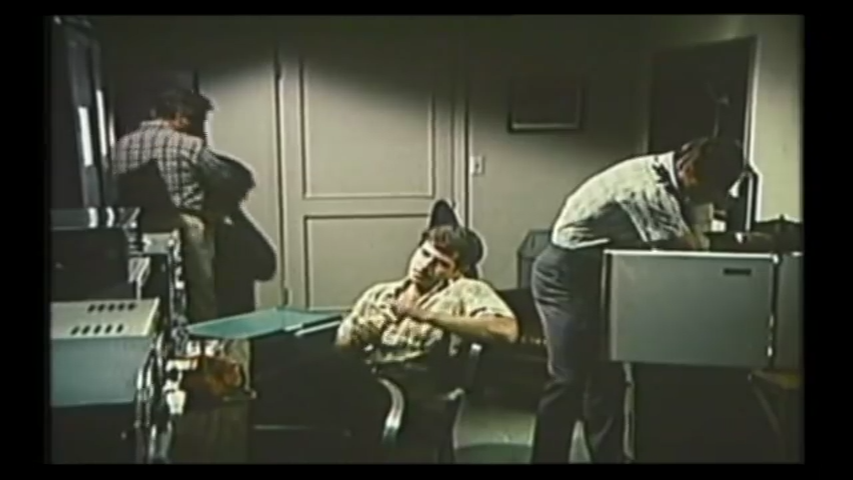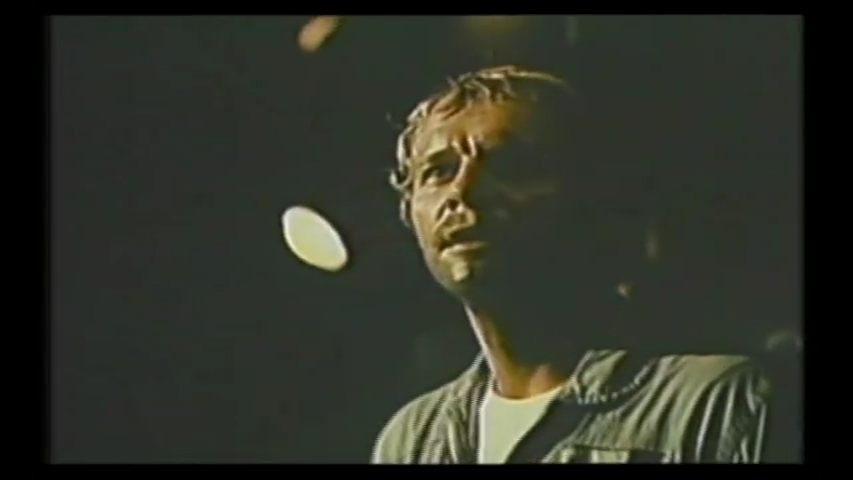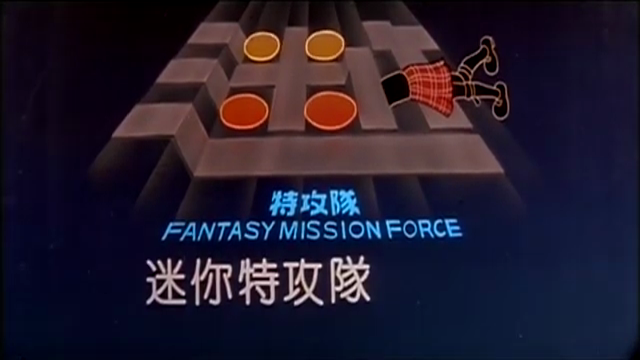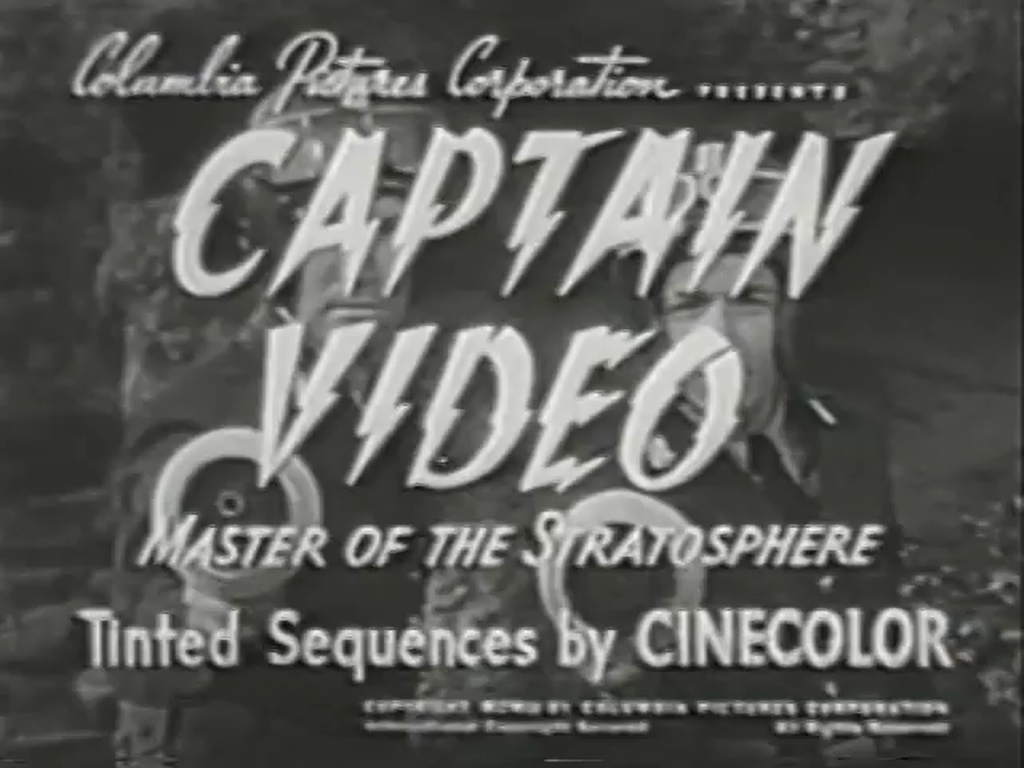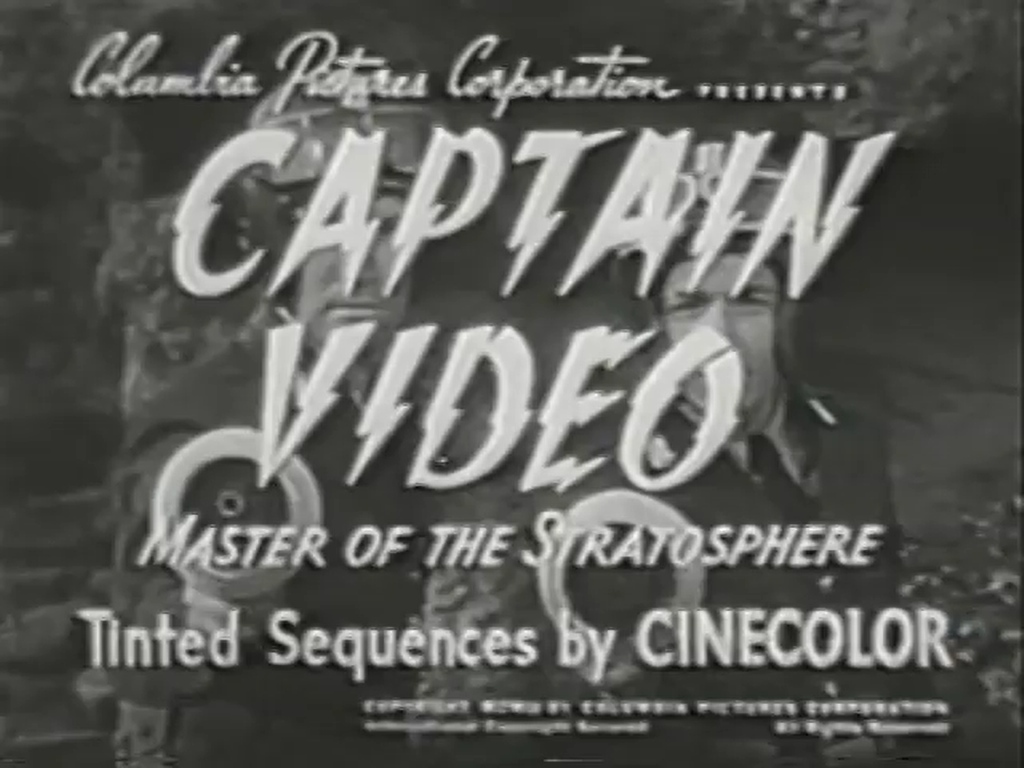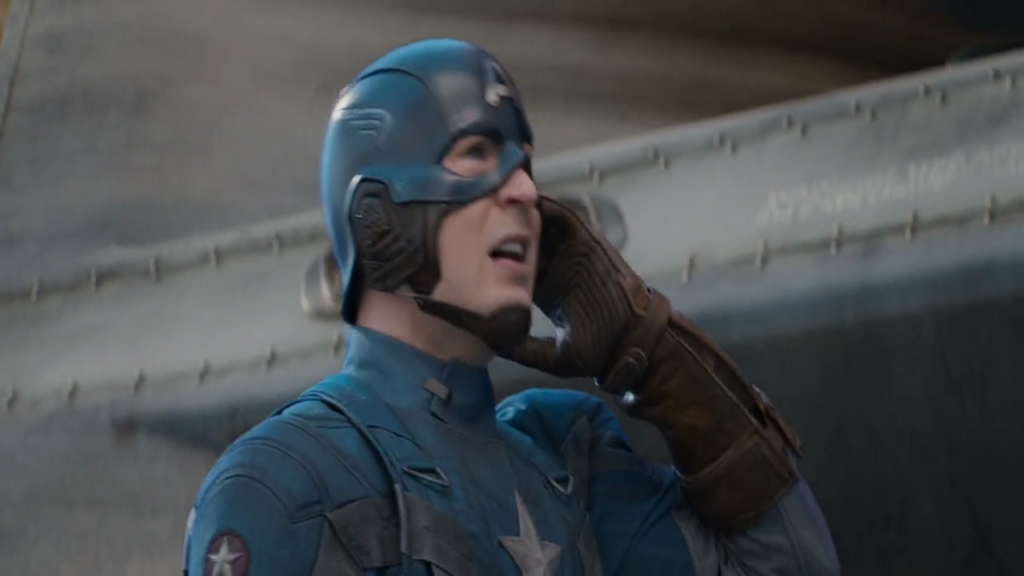-
#386 – Dick Tracy vs. Crime, inc.
Dick Tracy vs. Crime, Inc. (1941)
Film review #386
Directors: William Witney, John English
SYNOPSIS: Dick Tracy is assigned to deal with a criminal known only as “The Ghost”, who is able to turn himself invisible thanks to a special invention. The Ghost is after the members of a city crime council, who helped convict his brother Rackets Regan and sentenced him to death. It is a race against time for Tracy to stop The Ghost before he succeeds in killing all the remaining members of the council…
THOUGHTS/ANALYSIS: Dick Tracy vs. Crime, Inc. is a 1941 movie serial and the fourth Dick Tracy serial to be released in as many years. This time, Dick Tracy is on the trail of a master criminal who calls himself “The Ghost,” who also has the power to turn himself invisible thanks to a special machine. The Ghost is seeking to take revenge on the city crime council, who helped convict his brother Rackets Regan to death, and in the opening chapter, we see him take out one of the council members, and his daughter June Chandler, teams up with Tracy in order to stop The Ghost. The story combines two typical tropes of the movie serial format: one, an invisibility device which many serials have done, and two, the identity of the main villain is hidden behind a mask until they are exposed in the final chapter. As always, there’s nothing too unique about the way the serial uses these plot points, but again this Dick Tracy serial manages to use them better than its contemporaries, and create a well balanced serial with plenty of action and intrigue. The added sci-fi element makes it feel a little different from the previous Tracy serials too, which is what is needed in this fourth instalment. There is a fair amount of re-using stock footage from the previous serials for the cliffhangers at the end of each chapter, but honestly it doesn’t feel like that much of a problem, as you know they will always end up with Dick Tracy escaping just in time.
As the serial progresses, there is a range of villainous schemes that Tracy and his friends have to foil, as well as the mystery of The Ghost’s identity with adds an element of mystery to everything. There’s always plenty going on, and the dialogue never gets too dragged down in exposition. For this serial, Dick Tracy is the only returning character, although Billy Carr and June Chandler play the roles of Steve Lockwood, a fellow agent, and Gwen Andrews, Tracy’s secretary in an almost identical capacity. Ralph Byrd as Dick Tracy has always been the star of the serials, and as long as he returns, the rest of the cast are pretty inconsequential. The identity of The Ghost is kept secret throughout the serial, with suspicion falling upon various members of the council at different points, then shifted away as they are killed. Everything is tightly-knit together, and even though it does cut down the cast and re-use some footage, I think it may be the best serial out of them all: it perfects what it is trying to do, and even though it uses plot devices that have been seen in the serial format before, it does them a lot better. If you were going to only see one Dick Tracy serial, I would probably say to choose this one, as it exemplifies not only the best of Dick Tracy, but some of the best examples of the serial format.
-
#385 – Pass Thru (2016)
Pass Thru (2016)
Film review #385
Director: Neil Breen
SYNOPSIS: …I don’t know. An artificial intelligence travels to the present to help guide humanity, who have lost their way with war, crime and corruption. The A.I. takes the body of a drug addict and befriends two migrant children who have escaped smugglers after they cross the U.S. border while it carries out it’s work.
THOUGHTS/ANALYSIS: Pass Thru is a 2016 film. The film is written, directed by and stars Neil Breen, who has a track record for making many of these films single-handed. The film starts off showing some people smugglers getting some people across the U.S. border, and essentially imprisoning them. Meanwhile, a drug addict who helped them is given his payment in the form of drugs and passes out (or dies, I don’t know). Then an A.I. from a thousand years in the future turns up and takes his form…or possesses him? Nothing is really explained here. The A.I. says in one of its many, many monologues that humanity has lost its way through war, corruption and such, and in order to get it back on track he plans to kill about three hundred million people. That’s it. He befriends two of the smuggled migrants who managed to escape, who is converses with in between monologues and visiting corrupt bankers, lawyers and politicians before making them disappear. Oh and there’s a sub-plot with some kids and a professor watching outer space for anomalies or something. This film has little to no coherence or substance, and it obviously focuses on Breen professing his morality. Corruption, war and crime are bad: we already know this, and the film doesn’t really offer any solutions or interesting takes on it, instead just opting to make bad people disappear without showing any real consequence. The mix of monologues and dialogue scenes don’t come together, and all of the other characters don’t really make any contribution, lest they distract from Breen’s holy vision.
The A.I. is revealed to be called “Thgil”, which is obviously “light” backwards, and the film makes a major fuss over it, like it’s a creative revelation or something. Breen’s films always have him in the starring role as a very, very, very, very (very) thinly-veiled Christ figure whose mission is to unveil the corruption and evil in the world and fix it. I can’t help but feel this guy has a complex of some sort. As mentioned, it’s not exactly a revelation that the rich and powerful are corrupt, and war is bad, so I don’t see how this film is going to convert anyone to whatever Breen is trying to sell (kill three hundred million people? I don’t know).
So apart from the story being non-existent, the acting is all awful, and delivered so flatly and without life you can never be immersed in the film because every little gesture and speech sounds forced. The special effects could be done by anyone with a greenscreen and Photoshop, and the most ridiculous effect is the tiger that randomly appears throughout the film for no reason, especially when Breen tries to interact with it. There is also an obsession with drone shots with the film, since Breen clearly just bought one and wanted to fill the film with shots from it. The film might as well be about Breen buying a drone. Overall, Pass Thru is a one-man operation that tries to preach a message you already know. as a film the story is non-existent, the dialogue is forced, the acting is awful and the effects aren’t good enough to be described as amateur. It really does have to be seen to be believed, and might be worth a watch for a laugh if it doesn’t bore you to sleep first.
-
#384 – Dick Tracy’s G-Men (1939)
Dick Tracy’s G-Men (1939)
Film review #384
Directors: William Witney, John English
SYNOPSIS: F.B.I. agent Dick Tracy has successfully captured the international spy Zarnoff, who has been sentenced to death. However, he manages to escape, and picks up where he left off attempting to steal or sabotage military equipment to sell to the ‘three powers’, as Dick Tracy once again tries to stop him.
THOUGHTS/ANALYSIS: Dick Tracy’s G-Men is a 1939 film serial and the third Dick Tracy serial. In the opening, we see a film showing how F.B.I. agent Dick Tracy successfully captured foreign spy Zarnoff, who has now been sentenced to death by gas chamber. While in jail awaiting his sentence however, Zarnoff is sent a newspaper which is laced with a substance which when ingested, causes him to appear dead and stop breathing before he is taken to the gas chamber. While his body is being transferred, members of Zarnoff’s gang hijack the ambulance and steal his body, subsequently reviving him since the substance caused him to stop breathing before he went into the gas chamber, therefore did not breathe in any of the lethal gas (yes, it sounds a bit farfetched). When Dick Tracy learns of Zarnoff’s escape, he again attempts to catch up with him, as Zarnoff has sworn revenge against Tracy. The story, split into fifteen chapters, revolves around (as you would expect) Tracy attempting to foil the numerous schemes of Zarnoff, which, as is a staple of the Dick Tracy serials, outperforms others in the genre by having plenty of variety and imagination, splitting the time between investigation and action scenes. It still sticks rigidly to the serial format, and is essentially more of the same, but its predecessors were popular, so there isn’t really much need to drastically change them. The story around the spy Zarnoff attempting to sell American secrets to the “three powers” would have been more relevant to the time it was released, as World War II had essentially begun, so the theme of spies and espionage would have been particularly poignant, with the “three powers” clearly being a reference to the axis powers.
One more significant change in Dick Tracy’s G-Men was the thinning out of the cast. A number of the characters do not return, including Mike McGurk and Junior, who mostly provided the comic relief, and so the film does feel a bit more serious, again with the back drop of a world war looming. In fact, Ralph Byrd, who plays Dick Tracy, is the only returning actor. Even though the characters Steve Lockwood, a fellow F.B.I. agent, and Gwen Andrews, Tracy’s assistant still show up, they are played by different actors. The character Zarnoff is of particular interest, as he looks like a cross between Stalin and some east-Asian influences, which makes sense given the time of release, and America’s animosity to that area of the world (there were many serials produced around the second World war that utilised a villain that was made to look Chinese or east-Asian).
The pacing of the film is fairly standard, with a new scheme showing up every two or three chapters to keep things interesting, and the standard cliffhanger at the end of each chapter to entice viewers to return to the theatre next week to the next chapter. The ending sees Zarnoff and Tracy crash a plane in the desert, with the two handcuffed together, they are desperate to find water when eventually finding some, Zarnoff knocks Tracy out and uncuffs itself. When Lockwood shows up and finds Tracy, they see that the water contains Arsenic, and shortly find Zarnoff’s body (offscreen) as he has died from ingesting the water. Not exactly a thrilling conclusion, but they never are after investing so much time into these serials they never end on much of a high note. Nevertheless, Dick Tracy’s G-Men is more of the same, but it still maintains a position well above most of the format in terms of action, pacing and characters.
-
#384 – Dick Tracy Returns (1938)
Dick Tracy Returns (1938)
Film review #384
Directors: William Witney, John English
SYNOPSIS: F.B.I. G-man Dick Tracy is on the trail of the Stark family: A criminal gang consisting of “Pa Stark” and his five sons. When new G-man recruit Ron Merton is murdered by the Starks when they hijack a convoy, Tracy swears revenge and attempts to track them down while thwarting their many villainous schemes.
THOUGHTS/ANALYSIS: Dick Tracy Returns is a 1938 film serial and the sequel to the Dick Tracy serial released a year earlier. The story this time revolves around Dick Tracy trying to thwart the criminal enterprises of the Stark family criminal gang, led by Papa Stark and his five sons Champ, Trigger, Dude, Kid and Slasher (great names). The Starks have a range of schemes and crimes they try to carry out, and this gives the serial enough variety to see it through, as Tracy and his team have to stop them across land, sea and air, resulting in an array of chases, as well as some good old-fashioned detective work. The original Dick Tracy serial was a strong mix of serial elements that kept its momentum across its fifteen chapters. Dick Tracy Returns emulates that success and continues it. There’s not much new here, but since the original was a success, there isn’t any need to fix what is not broken. And of course, in an era without repeats on television or home media, it was easier to repeat things on screen as the only way to watch these serials was to go to the theatre every week for the next instalment.
Most of the protagonists from the first serial return with the same actors, which provides a good sense of continuity. The only real change is that a different actor plays Junior, but that’s not much of a distraction. There’s not much character development, but every character has a role to play, from the heroic Dick Tracy and Steve Lockwood, the humour from Mike McGurk, and Tracy’s assistant Gwen, there’s a decent amount of variety in the characters. The villains are also fairly interesting, and showing Tracy stop the individual sons of papa Stark makes the story flow a little easier. Like the first serial, Dick Tracy Returns is a good example of the movie serial format, and has plenty of action, distinguishable characters and thrilling cliffhangers to keep viewers coming back. It’s mostly par for the course for the serial format, but a good example of it.
-
#383 – Anna and the Apocalypse (2017)
Anna and the Apocalypse (2017)
Film review #383
Director: John McPhail
SYNOPSIS: Anna is about to finish high school and plans to travel for a year before going to university, much to her dad’s disapproval. However, a zombie outbreak and the onset of the apocalypse have altered her plans somewhat, and Anna and her school friends must find a way to survive the end of the world…
THOUGHTS/ANALYSIS: Anna and the Apocalypse is a 2017 comedy/horror musical. The film starts off introducing Anna, a high school student who is planning on having a gap year before starting university, much to her Dad’s dismay. Anna and her friends also have plenty of problems at school including the new authoritarian headteacher and the usual teenage trouble. All of these issues are bypassed however, when a zombie outbreak occurs and Anna must find a way to survive with her friends and find her father. The story is fairly standard and doesn’t offer a deep lore-filed story. It’s a zombie outbreak like every other zombie outbreak, and it isn’t integral to the story to go into detail with regards to its origins. What makes the film stand out is that it is also a musical, ending up as a musical.comedy/horror hybrid, the film takes on a lot of different tones, but for the most part I think it does a good job of handling the variety well.
The characters are well defined, and each of the students has their own personality and reacts to the apocalypse differently, which is the sort of diversity you would expect from a group of teenagers. The musical numbers also help in this regard, as each of the main characters has at least a song in which they express their emotions and opinions in a unique way.The songs aren’t so memorable that you’ll remember them after the film has ended, but they are catchy and enjoyable so that a wide range of people will enjoy them. They also help in allowing the viewer to invest in the characters and their emotions, which leaves more of an impact when they die…and they do die, because this film does get quite dark in places and makes you feel the weight of their sacrifices.
Anna and the Apocalypse is not a big production affair, but it doesn’t need to be, as it keeps its focus on the characters and small-scale scenes that feel very personal. I suppose it also counts as a Christmas movie, although it’s definitely not very festive. I can’t find much to criticise in this film: it works within its boundaries and creates a simple story crossing genres, with a diverse cast and personal interactions augmented by serviceable performances and music. It’s not rewriting the genre, but it’s more than entertaining enough to sit through as an alternative Christmas movie.
-
#382 – The Disappearance of Flight 412 (1974)
The Disappearance of Fight 412 (1974)
Film review #382
Director: Jud Taylor
SYNOPSIS: During a routine exercise, a U.S. military aircraft sees three UFOs on it’s radar screen, and two fighter jets are scrambled to intercept them. When the UFOs and the fighter jets disappear from radar, flight 412 is ordered to land and its crew is detained by a special investigations branch, who attempt to convince them that they saw nothing.
THOUGHTS/ANALYSIS: The Disappearance of Flight 412 is a 1974 TV movie. The story is based on the stories of UFO sightings, who knows about them, and how they are covered up. The movie starts off with a narrator recounting people’s experiences with sighting Unidentified Flying Objects in the skies, and their continued unexplanation. You had better get used to hearing the narrator, as they return constantly to explain the story, rather than letting the film speak for itself through the acting and dialogue. That said, I think the aim was to go for a semi-documentary feel, speculating about the nature of UFOs, which at the time had very little explanation or detail. The trouble is, with so little information about UFO sightings, you can’t really convey any information in a documentary style if it simply doesn’t exist.
The story of the film deals with the crew of a military aircraft, who are launching an exercise to try and solve an electrical problem aboard the aircraft. While in the air, they see three unidentified flying objects on their radar, and two additional fighter jets are dispatched to investigate. The jets and the UFOs eventually disappear from the radar, leading to a Special Investigations Division ordering the plane to land and the crew being detained. They are interrogated and the investigators attempt to convince them that they saw nothing on the radar, and there were no jets. Meanwhile the colonel who dispatched the aircraft can’t get into contact with them, and tries to find out what has happened. A lot of the story revolves around dialogue in dimly-lit rooms and back-and-forths between the various divisions of the military and government. Over time it become difficult to follow as everyone really looks and acts the same, and the motive for wanting to cover-up the UFO is never revealed: it is never shown whether they were aliens, top secret military technology or anything like that. Leaving it a mystery is probably more appropriate for the semi-documentary tone, but it does leave the whole experience somewhat pointless without any answers or payoff. The characters are all bland and uninteresting (again, in aims of keeping it down-to-earth (pun intended)), but there’s some more interesting moments when the crew are being detained and – for lack of a better term – psychologically tortured into believing that what they saw did not happen. However, they are too few and far between to make the film interesting overall.
Being a 70′s TV movie you won’t expect a big budget and spectacular special effects, but for a film about UFOs everything does look a little boring. The shots of the cockpit when the aircraft is in the air is clearly done in a studio, and the plot gets even more confusing due to the various offices and locations which different characters are in all look the same. Every scene is also accompanied with some odd lighting which I guess is meant to give dramatic effect, but just makes everything look dark and difficult to differentiate characters and there expressions. While such a semi-documentary might have been an interesting speculation on the nature of UFOs in 1974, The Disappearance of Flight 412 isn’t really of interest today, and as a story it’s pretty dull and devoid of content.
-
#381 – Dick Tracy (1937)
Dick Tracy (1937)
Film review #381
Directors: Alan James, Ray Taylor
SYNOPSIS: F.B.I. G-man Dick Tracy is on the trail of the criminal gang known as the Spider Ring. They have invented a flying fortress called The Wing and it is Tracy’s job to find a way to stop it and the gang’s evil schemes. Alongside this, he is also trying to find his brother Gordon, who has gone missing, and unbeknown to Dick, has been brainwashed by the Spider Ring to do their bidding…
THOUGHTS/ANALYSIS: Dick Tracy is a 1937 movie serial based on the comic book character of the same name. The serial stars, unsurprisingly, Dick Tracy, who is a “G-man” working for the F.B.I. investigating crimes, specifically trying to bring down the criminal gang known as the Spider Ring, who leave the mark of a spider on their victims before they kill them. Dick also has to find out what has happened to his brother, who has gone missing, and unbeknown to him has been captured by the Spider Ring and been brainwashed into becoming their servant. The serial’s story unfolds across a lengthy fifteen chapters, with the usual serial shenanigans taking place. Despite the length, the serial does a good job of keeping things interesting, and has a number of mini-arcs in the story to keep things varied. Dick Tracy’s character as a criminal investigator plays a strong role in the story, as he is actually investigating the crimes and following the evidence, rather than just showing up and getting into a fistfight like a lot of these serials.
The action scenes are also well varied, with their being chases across land, sea and air. The aerial scenes are probably the most interesting, as they are fast-paced and have plenty of stunts. The real sci-fi element of the serial comes in the form of The Wing: a large plane that resembles a flying fortress crossed with a stealth plane. It is the sort of thing that would not have been seen before when it was released, so it certainly gives the serial some originality. While The Wing plays a large role in the earlier chapters, it appears less frequently in the later ones, which is a shame since it probably had some more potential, but there’s plenty of other things going on so it doesn’t feel like the serial runs out of steam.
As mentioned, Dick Tracy’s role as a criminal investigator gives him plenty to do, and separates him from the similar white-male leads of these type of serials by giving him a unique character trait. The cast of supporting characters is quite large, but they all serve a purpose and you can tell them apart. The comedic relief in the form of the young Junior and his guardian McGurk aren’t overplayed, and provide just enough of a contribution to the story without being distracting. The villains, including the leader of the Spider Ring known as “The Lame One” are also well varied, including the rogue doctor Moloch who performs the operation to brainwash Gordon Tracy (who also has his face changed, which is rather pointless as none of the heroes see his face that would recognise him). The Lame One’s identity is kept a mystery until the end, but if you follow the serial closely, you can probably tell who it is, and it doesn’t act as too much of a revelation. Nevertheless, an overall interesting cast that are recognisable and add different dynamics to the serial.
The special effects of the film are pretty good for the time, and while a lot of the plane stunts are done with models, they are still convincing. A lot of the aerial stunts are pretty implausible and flying the face of physics, but given that cinema goers in 1937 would probably have not been in a plane (or maybe even seen one), it’s not going to break the immersion. Overall, Dick Tracy manages to take the typical aspects of the serial format and excel with them: the action is varied, the story is full of drama and suspense, the characters are well-defined, and there’s plenty of content to keep viewers coming back to the theatre every week.
-
#380 – Fantasy Mission Force (1983)
Fantasy Mission Force (1983)
Film review #380
Director: Kevin Chu
SYNOPSIS: Four of the world’s top generals have been captured by Japanese forces. In order to rescue them, Lieutenant Don Wen assembles a squad of misfits to undertake the perilous mission. The squad must brave tribes, ghosts and Nazis in order to accomplish their mission, all the while being followed by Sammy and Lily, a pair of con-artists looking to get the reward that the squad have been promised…
THOUGHTS/ANALYSIS: Fantasy Mission Force is a 1983 action comedy film. The film opens up with a group of generals from different countries dressed in stereotypical uniforms being captured by Japanese forces (the Japanese are usually the enemy in Chinese films). The generals include the French “Pierre Retreat” (sly jab at the French there) and the American “Abraham Lincoln”. But this is only the start of the madness that this film throws at the viewer. We next see world leaders trying to formulate a rescue plan, looking through various people who might be able to pull it off, including 007, Snake Pliskin, and Rocky Balboa, all of whom are for some reason or another are unable to do it. With this in mind, Lieutenant Don Wen assembles a squad of the world’s most bizarre specialists in order to pull off the rescue. Alongside this, a pair of con-artists, Sammy and Lily, are following the group as they try and get a hold of the vast reward. The story, as you can probably tell from the outset, makes very little sense and is all over the place. I think the film is supposed to be set during WWII, which makes things even stranger when they bring up 007, Pliskin and Rocky who would not have even been alive then, alongside the vehicles definitely being not of the time period. As a comedy action film I suppose you can’t be too concerned about the integrity of the story, but it is so disjointed and all over the place that it is difficult not to pay attention to it.The story behind Jackie Chan being in the film is equally as strange, as the director apparently saved him from being killed in a mob hit, and Jackie Chan contributed to the film to pay him back.
The group eventually wanders into a tribe of women, who take them prisoner, leading them to escape to a house that is haunted by ghost and vampires, before finally reaching the Nazi outpost where the hostages are being held. Again, all these different settings and characters add up to a very surreal experience which, while full of variety, really have no connection to each other. The film also has musical numbers too, just to make things even weirder. Nevertheless, the characters all have their own personalities and roles to play, so that helps keeps things consistent if nothing else does. There’s the drinking cowboy-character, the arguing couple, the comedic relief characters and more who have their own distinctive ways. Another of the film’s positives is the martial arts choreography, which is fluid and fun, although dubbed with awful sound effects. Overall, it’s difficult to be to harsh on Fantasy Mission Force: it’s clearly a low budget picture so you can’t expect much, but it is full of so many nonsensical settings and bizarre characters that you can’t help but marvel at their overall ridiculousness. It certainly isn’t boring, and you can easily be entertained by looking for all the different elements that do not go together. Its a fun, if nonsensical, film.
-
#379 – Captain Video: Master of the Stratosphere (1951)
Captain Video: Master of the Stratosphere (1951)
Film review #379
Director: Spencer Gordon Bennet, Wallace A. Grissel
SYNOPSIS: The heroic Captain Video and his Video Rangers from across the globe help maintain peace on the planet Earth, but when Earth becomes subject to meteor bombardments from the planet Atoma, Captain Video must find a way to thwart the evil schemes of it’s leader Vultura before it is too late…
THOUGHTS/ANALYSIS: Captain Video: Master of the Stratosphere is a 1951 movie serial. The serial stars (as the title suggests) Captain Video, the leader of an organisation called the Video Rangers, who help protect the Earth. When the Earth becomes subject to meteor bombardments originating from the planet Atoma, Video must stop them before they can invade the Earth. The plot resembles the vast majority of sci-fi serials, which copy the highly successful Flash Gordon and caught the genre in a thinly-veiled repetition of its plot and characters for over twenty years. A lot of the story revolves around Captain Video trying to prove that the scientist Dr. Tobor (yes, that is ‘robot’ spelled backwards) is working with Atoma’s leader Vultura, as Video and Vultura try to outsmart and thwart the other’s plans. I think this format and plot structures were gotten away with for two reasons: one, there was no way to re-watch old serials once they had first aired at the theatre, so new ones could come out with the same story and similar characters; particularly since serials such as this would be aimed at kids, who would not have seen earlier serials. The second reason being that the second world war probably didn’t leave much room or money for the development of anything too original or ambitious, as resources would have been focused elsewhere. Nevertheless, by the time this serial was released in 1951, there probably should have been some effort to change the formula or offer something new.
Despite it’s lack of originality in the story department, there’s still a decent amount of variety going on. The early chapters see Video travelling to the planet Theros, where the peace-loving people are under attack by Vultura’s forces, and Video has to teach them to be guerrilla fighters and fight back. Again, this plot structure shows up in many previous serials. The next major chunk of the serial consists in the back-and-forth between Tobor and Video, as they try and outdo each other on Earth. Video and Vultura only meet in the final half of the last chapter, which feels like a waste. The serial however, does keep things interesting with a whole host of gadgets and inventions that would undoubtedly spark the imaginations of youngsters watching. The guns that the Rangers use that shoot out sparks are quite a nice effect of the time. However, the serial often falls into the trap of explaining what is going on and what all these inventions do rather than actually showing them, mostly due to budget constraints, but often the plot is explained before it happens, leaving little surprise or tension. The inventions too have bizarre technological names, and accompanied techno-babble that try to justify the implausible things they do.
Most of the characters are based off the ones on the TV series, with Captain Video being the typical white American male hero that is the star of all these serials. His younger sidekick is strangely only referred to as “the Ranger” and never given an actual name. This is in keeping with the TV series, but other rangers are shown to use their own names, so it’s odd that he doesn’t. Maybe it’s a way to get kids to imagine themselves in the role of the young teenage sidekick, as anyone could be “The Ranger”. There’s also Ranger Gallagher, who does all the technical stuff at Video headquarters, and Vultura clearly has some east Asian influences in his design, again echoing the “Ming the Merciless” type villain that originated in Flash Gordon. One final note about the characters is that while you will expect these serials to only feature a white cast, there is not a single woman anywhere featured in the serials fifteen chapters. Often there is usually a solitary token female character that sometimes serves as the protagonist’s love interest, but there is none at all here, not even in any of the backgrounds. I suppose the lack of a female character could be attributed to the fact this is geared towards a younger, male, audience, who would not be interested in a female character or a romance sub-plot, but having this cast of inter-changeable white men interact with each other really emphasises the monotony of the story at points.
The serial was directed by Spencer Bennet, a veteran of these kinds of serials, so he had plenty of experience in what to do. Some of the effects are fairly decent; as mentioned, the ray guns the Video Rangers use is pretty cool, and their super-fast car stands out with its unique look. There is also a ‘space platform’ which allows transportation between earth and Atoma, which apparently is millions of miles away. Captain Video also has a rocket ship he travels in, which again adds some variety. Some of the effects (such as the rocket ship in flight) are done through using hand-drawn animation, which allows a lot more freedom in terms of effects, although this is not the first time this was done, having been integrated into the Superman serial a few years earlier. Overall, I think I can place the Captain Video serial just above average in the miasma of similar sci-fi serials: it has a lot of the well-worn tropes and characters, but has some decent effects and various inventions that add a bit of extra spice. It’s obviously meant for a younger audience, but there’s enough content for those who haven’t seen such a serial before to enjoy.
-
#378 – Captain America: The Winter Soldier (2013)
Captain America: The Winter Soldier (2013)
Film review #378
Directors: Anthony Russo, Joe Russo
SYNOPSIS: When S.H.I.E.L.D. director Nick Fury is assassinated, Steve Rogers (Captain America) is on the trail of those responsible, but he is told to trust noone. As he investigates, he finds a shocking discovery that goes right to the heart of S.H.I.E.L.D. itself…
THOUGHTS/ANALYSIS: Captain America: The Winter Soldier is a 2013 superhero film that forms part of the Marvel Cinematic Universe (MCU). The film starts off with Captain America in the thick of a mission to rescue hostages from a S.H.I.E.L.D. ship. There’s plenty of fluid action that provides a strong opening for the film that requires no knowledge of the characters, and eases into the story in a fun and exciting way. The plot takes on a number of twists and turns as S.H.I.E.L.D. director Nick Fury is seemingly assassinated and Captain America must investigate S.H.I.E.L.D. itself with the help of Black Widow. The film mixes layers of action, espionage and intrigue as it unravels the conspiracy surrounding S.H.I.E.L.D. It’s a strong story that will keep viewers engaged, as well as exploring the character of Captain America and elements of the Marvel Cinematic Universe. It is a fine balance to give each of these elements the right amount of focus, but the film largely succeeds in doing so. If I were to pick an issue with the story, I would say that there’s a bit of a conflict between the film being self-contained and its part in the larger cinematic universe, insofar as the revelations about S.H.I.E.L.D. should have significant ramifications, but it seems they are more or less curtailed by the end in order to keep the film self-contained with a distinct resolution. Overall though, the story is fairly strong.
Captain America as a character is a soldier, a leader and a hero, and I think all of those aspects to him are given a good amount of development. How he relates to those around him and what his part is in protecting and inspiring them is something he has to constantly work through as the film progresses. The supporting cast of Black Widow and Nick Fury also get ample screen time in order to develop their characters and play a significant role in the story. The “winter soldier” also has ties to Captain America, and with everything else going on, it feels like there could have been more done with his character, but this instead seems to have been postponed in order to be dealt with in a sequel. Villains typically get short-changed in these films, as they are almost entirely self-contained in the film and do not get referenced outside of it. Pearce, the villain here, is a bit more interesting, and has particular relations with a number of characters. He doesn’t have any particular superpowers, so he’s more of a mastermind, with the winter soldier handling the action parts of the villainy. Sam Wilson, a veteran soldier, also has an interesting character arc which gives Captain America a bit of a grounding as he interacts with the soldiers without superpowers who go to war. A lot of characters, but again it’s all handled fairly well.
The style and effects in the film are just about what you would expect from these Marvel films. There are no surprises, but it has a good budget, and keeps things consistent. The fight scenes are well choreographed, and highlight the strengths of the characters. There’s nothing overwhelmingly special about the film, but it has a lot of content that pushes and develops characters in new directions and explores new facets of their characters. Like with most Marvel films it’s not going to re-define the genre, but it shows a marked improvement on earlier sequels in the MCU (Iron Man, Thor) by focusing a little more on interesting character development, varied villains and weaving a stronger story around the heroes.









